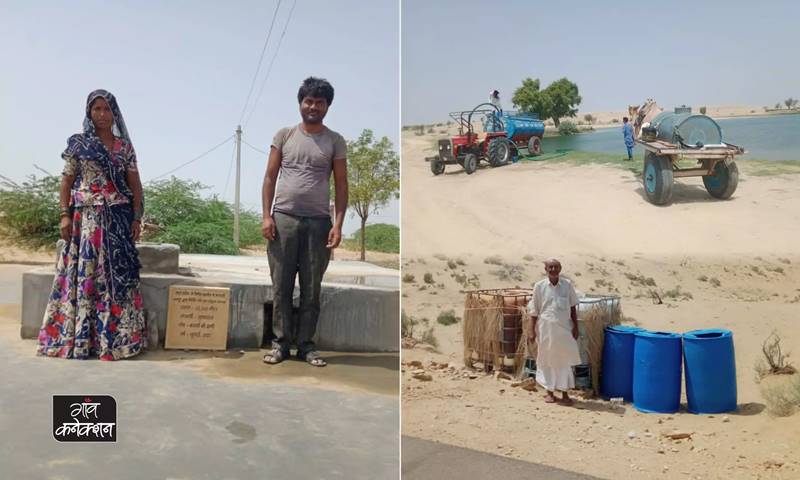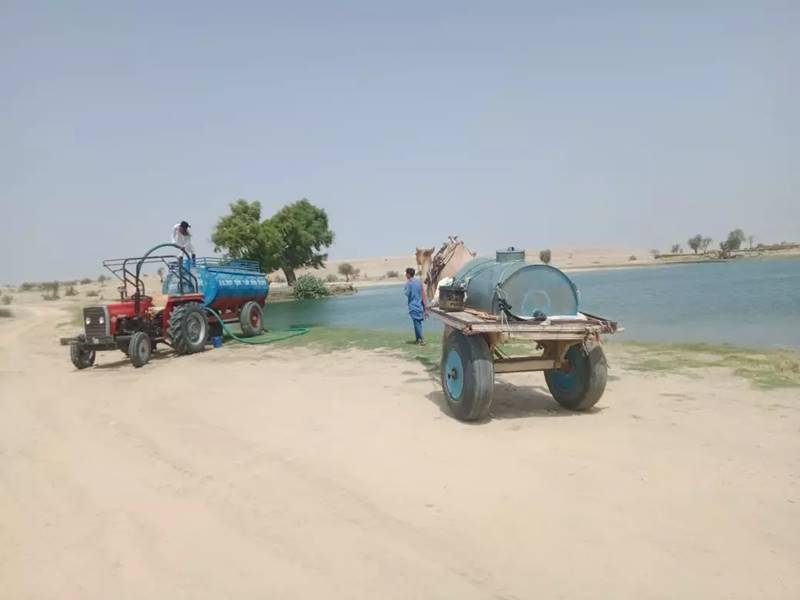Villages in Jaisalmer stare at drought but Banjaron Ki Dhani has clean and safe drinking water
This monsoon season, Jaisalmer in western Rajasthan has received next to no rainfall. But a rainwater harvesting initiative has helped a nomadic community in the desert district to capture rainwater and collect sufficient water for drinking purposes.


As part of the initiative, eleven water tanks have been constructed for 11 of the 46 families in Banjaron Ki Dhani. All photos: By arrangement
Jaisalmer, Rajasthan
The monsoon rainfall in Jaisalmer this year has been pitiful and whatever little precipitation occurred dried up in the blistering heat of the desert state. However, in Banjaron Ki Dhani, a village located not more than 60 kilometres away from the border with Pakistan, the residents have sufficient water for the next two months. And the credit for this goes to the villagers who have successfully captured every drop of rain that fell from the sky this monsoon season.
Jaisalmer is a drought prone area and poverty is rife. Most people live in kuchcha homes and there is no arrangement to collect or store rainwater.
In March this year, a pilot project was kicked off in Banjaron Ki Dhani, that falls within Ramgarh panchayat, in Jaisalmer district, to provide safe and clean drinking water to its residents. And the source of this water was to be the rainwater. When it rained in July this year, the nomadic inhabitants in the village collected the rainwater, which they hope will last them for the next month or two.
As part of the initiative, eleven water tanks have been constructed for 11 of the 46 families in Banjaron Ki Dhani. Nearly 1,300 square feet in size, water collected in each tank could easily supply water to a family of five to six members depending on the rainfall that year. This project was launched in March 2021 when Prime Minister Narendra Modi launched the ‘Catch The Rain’ initiative as part of the Jal Shakti Abhiyan.
“We had rains just once in Jaisalmer. Even so, we could collect approximately five thousand litres of water in our tank,” 35-year-old Jugta Ram told Gaon Connection. He was confident that the collected water would keep them going for an extended length of time. “If we have more rains, I am confident these tanks will provide enough water for the entire year,” he added.

Constructing tanks to capture rainwater
The cost of constructing each tank was Rs 84,500. Of this 25 per cent was paid by the families that could afford to do so. Those who did not have the money contributed in kind through shramdaan (voluntary labour) by digging and building the tanks.
Also Read: ‘Green’ energy projects threaten to wipe off ancient ‘orans’ in Jaisalmer, Rajasthan
Water pipes were laid out on the terrace of the homes to transport the rainwater that fell there into the tank. That is the reason why those families with pucca homes were selected for the pilot project, informed Varun Sharma, the Jaipur-based programme director of Aravali (Association for Rural Advancement through Voluntary Action and Local Involvement ), an organisation established by the government of Rajasthan in 1994 which is implementing this rainwater harvesting project. Water purifiers are also in the process of being installed in these tanks, Sharma said.
These tanks have been built in collaboration with Water Harvest, a non profit based in the United Kingdom that works with rural communities in India to help them catch and store rainwater.
“The Prime Minister had said that the Jal Shakti Abhiyan should be a people’s movement. He wanted it to be one where there was work done at the grassroots level along with the contribution of local inhabitants,” said Sharma. “It was this thought that made us start a project in some of the most backward areas of the state,” he added.
Also Read: The desert coolers of Rajasthan
“We, along with Water Harvest, selected a marginalised community that lives on the fringes of Jaisalmer district. And, eleven water tanks were constructed,” Sharma explained.

According to him, these eleven families were the only ones in the village with pucca homes. The people in this region of western Rajasthan are extremely poor and most of them have only kuchcha houses, the programme director pointed out.
The technique used for rainwater harvesting in Banjaron Ki Dhani ensures not a drop of rainwater is wasted. “We have done everything to ensure that each of these eleven families get clean drinking water all year through,” Omprakash Sharma, country director of Water Harvest, told Gaon Connection.
Also Read: Large-scale deficient monsoon rainfall across Odisha triggers fear of drought
Succour to parched families
“We spend the most time trying to organise water for our daily use. We have to walk two to three kilometers to collect water and bring it home,” Jatav Devi, a beneficiary in the rainwater harvesting project, told Gaon Connection. Sometimes villagers had to buy water by paying as much as Rs 700. “But, not all can afford that amount,” said Jatav Devi, who lives with her husband Jugta Ram, two sons and two daughters, and the main occupation of the family is rearing sheep or working as labourers.
“Thirty to thirty five per cent of the income of the people living in Banjaron ki Dhani goes into acquiring water,” Arvind Narayan, a local social activist, told Gaon Connection.
“A family of six members requires at least four tankers of water a month and each tanker costs up to eight hundred rupees,” Narayan added. “While the tankers get water from the Indira Gandhi Canal and it is drinking water, it is not clean, as cattle bathe in this canal,” he said.

The recently completed Catch The Rain initiative in Banjaron ki Dhani will now provide clean and safe drinking water to at least 11 families in the hamlet.
The next phase of the initiative will move to another village, Tanot, about 65 kms away from Banjaron ki Dhani, and only 15 kms from the India and Pakistan border.
“Preparations are underway to launch the project across the Tanot panchayat, to make safe and clean drinking water available to the inhabitants there,” said Narayan. According to him the baseline survey is on. The initiative plans to cover 35 families in Tanot.
“The pilot project at Banjaron ki Dhani has been successful and our intention is to ensure that we create a model in the desert of Rajasthan that will become a source of inspiration for the entire country,” Varun Sharma told Gaon Connection.
Read the story in Hindi.

